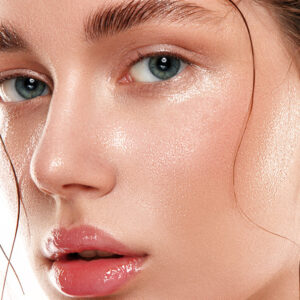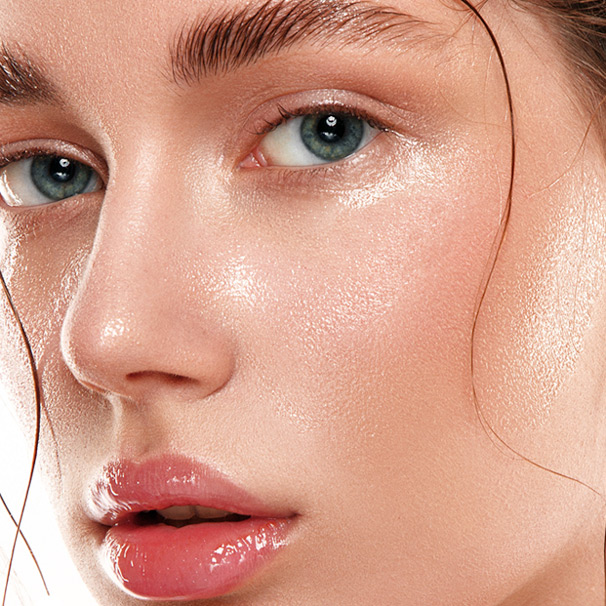Oily Skin
Anyone struggling with greasy, shiny, oily skin might argue that the mere existence of sebum (the medical term for skin oils) is a curse. Yet Mother Nature intended for it to serve a beneficial purpose.
The Good, The Bad & The Oily
The source of all the trouble is the microscopic sebaceous gland, safely hidden beneath the surface of the skin. Sebaceous glands are part of the pilosebaceous unit (hair + oil gland duo). These glands (envision partially inflated balloons) lie deep within the dermis. They connect with the hair shaft and empty their contents onto the surface of the skin through the pores. All skin surfaces, with the exception of the palms and soles, possess sebaceous glands. The area with the most oil-producing ability is the one most crowded with sebaceous glands - it's the notorious T-zone (forehead, nose and chin).
Sebaceous glands produce sebum, a complex blend of varied lipids (an assortment of fats), and dead sebaceous gland cells, (the cells that manufacture the sebum). Fats found in sebum include triglycerides, wax monoesters, squalane and free fatty acids.
The Good
Under normal circumstances, these glands should play a normal role in lubricating the skin and hair, protecting them from environmental challenges like dehydration and maintaining health and luster.
The term acid mantle refers to the protective, acidic environment created by the milieu of sebum, surface cellular debris and sweat bathing the outer layers of the skin (epidermis) and hair. The pH of the acid mantle ranges between 4.5-5.5. The acid mantle forces epidermal and hair cuticle cells to lie flatly in a tight array much like shingles on a roof. Without it, cells can pull apart, leading to dehydration, irritation and sensitivity. Hair can become brittle, dull and prone to breakage. The loss of an acidic environment can also lead to the invasion of bacteria into the skin.
Adequate amounts of sebum are very important in maintaining the protective acid mantle. Conquering oily skin is therefore a challenge. One wants to create a non-greasy, mattified appearance yet avoid over-stripping protective surface oils.
The Bad
Anyone who suffers from oily skin knows when too much sebum is produced, it's a real problem. Oily skin has a terribly negative effect on self-esteem as well as body image. Greasiness and shine often outweigh acne concerns. Oily skin is both uncomfortable and cosmetically unacceptable.
Sebaceous glands working overtime is the cause of excessively oily skin. Too much sebum produces surface oiliness, blocks pores, provides nourishment to bacteria that live upon the skin (P. acnes) and contributes to acne flare-ups.
The Oily
The true cause of oily skin lies in one's genetic makeup - an excess of a hormone called dihydrotestosterone (DHT). Too much of a good thing, this metabolite of testosterone, DHT is responsible for triggering sebaceous glands to produce sebum. Higher than normal levels of this androgenic hormone, or an increased sensitivity of the glands to normal levels of DHT can result in a virtual oil slick.
DHT first appears at puberty in both girls and boys. The menstrual cycle affects DHT levels, paralleling the rise of progesterone (post ovulation). Ever speculate why your skin becomes oilier and acne-prone just before menstruation? Blame rising levels of progesterone (and ultimately DHT).
Perhaps you have been praying your oil-laden T-zone would suddenly vanish overnight and be replaced with a healthy, radiant complexion. The goal is realistic even if the timing is not. However, eliminating extreme oiliness must be done with care. It's vital not to give in to skin-traumatizing temptation.
CLEANSE, TONE, MATTIFY
Cleanse
When it comes to cleansing oily skin, using a blend of salicylic and buffered glycolic acid work synergistically to dissolve heavier fatty surface oils and deeply cleanse the epidermis. DERMAdoctor Ain't Misbehavin' AHA/BHA Cleanser leaves skin feeling clean, fresh and glowing.
Astringents & Toners
True, toners can cut through oils, but all too often they also strip away the skin's protective barrier. DERMAdoctor Ain't Misbehavin' Toner was created to be a "good for your skin" toner. It's base contains both buffered glycolic and lactic acid, which gently yet effectively cut through grease and grime through chemical exfoliation. Plus it contains anti-aging antioxidants, protective non-comedogenic hydrators and oil busting botanicals.
OIL BUSTING TIPS
Masques
Masques may effectively reduce the feeling of oiliness on the skin for several days. A clay base lifts excessive oil away from the skin. DERMAdoctor Ain't Misbehavin' Intensive 10% Sulfur Acne Mask & Emergency Spot Treatment contains therapeutic additives to deal with some of the acne causing issues as well. This masque can help exfoliate materials lodged deep within the glands as well as reduce the presence of oils.
Retinoids
This category includes prescription Retin A, Retin A Micro Gel, Differin, Tazorac and Avita as well as OTC DERMAdoctor Poetry In Lotion 1% Retinol. Topical Vitamin A based formulas unquestionably help oiliness. However, a sizeable minority of patients still develop redness, flaking and irritation despite appropriate use of prescription retinoids. Poetry in Lotion provides high potency retinol with fewer high potency problems.
Oil Blotting Papers
Blotting papers blot. It's that simple. There are a variety of oil blotting papers on the market. While some people erroneously think that they may aggravate oily skin conditions (untrue), again, they are simply reducing the shine that may develop on the skin throughout the day. The use of agents to help reduce oil production in the first place will provide a broader fix of the problem. Having blotting papers on hand are a life saver for the very oily.
Sunscreen
In addition to following an oil-busting skin care routine as mentioned above, what to do about sunscreen? When answering scads of consumer email, inevitably the biggest resistance from those with oily or blemish prone skin is about sunscreen. Too greasy, too sticky, blocks my pores...the list of reasons to avoid its use is endless. Look for something light weight and oil-free.
Accutane
I personally do not feel that oily skin alone justifies the use of Accutane. Accutane is a great medication for the treatment of severe cystic acne, but has significant side effects associated with its use. The FDA does not indicate the use of Accutane for the control of oily skin. While I do hear from clients that they wish they could take this medication solely for controlling excess sebum production, it's just not a medically indicated use. A topical version of isotretinoin (the generic name for Accutane) has been tried in Canada and Europe for acne treatment but is unavailable in the U.S. I've only had the opportunity to see one patient who has relocated and was using this product. The skin was very parched (over-stripped of oils) and there was little change in the acne.
Systemic Interference With DHT
Less available DHT means less stimulation of the sebaceous gland and ultimately less oil production. Medications currently exist that block the ability of the hormone 5-alpha reductase to convert testosterone into its gland-triggering form, DHT. Currently none of them are prescribed with an FDA approved use to treat oily skin. However, in rare instances, an off-label use may be considered by a dermatologist.
Birth control pills (those that are more estrogen dominant), hair loss medications for men (such as Propecia which cannot be taken by women of child-bearing age/ability ), Spironolactone (a diuretic often given to treat acne, off-label, because of its antiandrogenic effects), and the antiandrogenic cyproterone acetate (not available in the U.S.). The most likely treatments your physician might prescribe would be a the oral contraceptive Ortho Tri-Cyclen or the water pill Spironolactone, both of which are currently used in acne treatment (with the side benefit of oil-reduction).
COMMON MISCONCEPTIONS
- Using oil control products will lead to an increase in sebum production.
This is absolutely false. - Blotting facial oils helps to reduce the production of sebum.
False. While blotting can provide a temporary method of removing the oil, just like topical oil control products, they have no affect on the production of sebum. - Oily skin is not a concern for those with rosacea.
Again, false. While rosacea sufferers are more likely to have drier, more sensitive skin due to the natural aging process, I have seen more than my share of significantly oily skinned rosacea patients. DERMAdoctor Calm Cool & Corrected contains NDGA, an ideal botanical for this concern. Combined with sebum sequestering micro-particles, excessive oils are absorbed, yet the product is formulated in a base appropriate for the rosacea patient prone to skin sensitivity. - Accutane fully eliminates ("cures") oil production.
False. While Accutane does normalize the faulty mechanism related to the formation of cells lining the sebaceous glands, which in turn stops cystic acne, sebum production is not entirely eliminated. After treatment, the skin may either remain non-greasy or experience a return of oiliness post treatment. - You can't wear make-up while using oil control products.
False. Make-up should be labeled oil-free or "non-comedogenic" and is appropriate for use by those with oily skin. It may also be applied on top of products that help control acne or oily skin conditions. For those more affected by excess oils, despite the use of some oil control products, the use of a powder base may help. Rice powders like those used in some mineral makeup feel light, don't plug pores and help absorb excess oils. - Oil control products cause unpleasant dryness and irritation.
While many oil control products which reduce levels of facial skin oils may cause these problems, this is absolutely not true across the board. And product misuse or overuse can also be responsible for skin irritation, not just the product formulation.
Now you know all about how to improve your oily skin condition. There is a wide range of options for you to take advantage of. Remember that when all else fails, your dermatologist is the perfect resource for prescription intervention.
Thank you for taking the time to read my newsletter. As always, I hope you have found it informative.
Audrey Kunin, M.D.
This content is sponsored by DERMAdoctor. The author receives compensation for its creation. All content is the legal copyright of DERMAdoctor, Inc, and it may not be used, reprinted, or published without written consent. The information provided is for entertainment purposes only and is not intended to provide medical, legal or other professional advice.



4 Comments